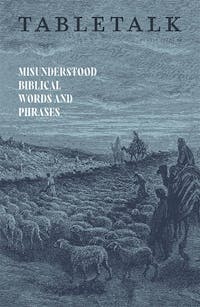
Request your free, three-month trial to Tabletalk magazine. You’ll receive the print issue monthly and gain immediate digital access to decades of archives. This trial is risk-free. No credit card required.
Try Tabletalk NowAlready receive Tabletalk magazine every month?
Verify your email address to gain unlimited access.
The eagle in flight is a picture of serene beauty and majestic strength. It is not without reason that nations and empires, both ancient and modern, have embraced the eagle as their symbol, and one who is acquainted with the Scriptures will certainly call to mind God’s bearing His people “on eagles’ wings” (Ex. 19:4) and causing them to “mount up with wings like eagles” (Isa. 40:31). Such words stir the heart and inspire the poetic imagination, but what exactly do they mean? What is the actual theological reality behind the literary metaphor in Scripture? To understand this more fully, it is helpful to take in a fuller range of references to eagles and eagles’ wings in Scripture.
For starters, the eagle is portrayed as a bird of prey (Job 39:27–30), and in keeping with this idea, the most common way that eagles are referenced in Scripture is as images of devastating, swift, and unstoppable judgment. Judgment (generally in the form of an invading nation) comes “swooping down like the eagle” (Deut. 28:49) or “swiftly like an eagle” (Jer. 49:22) or “like an eagle swift to devour” (Hab. 1:8). Mighty foreign nations in the Bible (such as Babylon and Egypt) are often portrayed as an eagle (Ezek. 17:3, 7; Dan. 7:4). So in the Scriptures, “the eagle’s wing” often brings swift and unstoppable destruction and death.
Yet at the same time, the eagle is also portrayed as a nurturer and protector of her own chicks. Job 39:27–30 speaks of the eagle as a bird of prey, but it also highlights that the eagle seeks its prey to feed its young, who dwell secure in the “nest on high . . . the rocky crag and stronghold.” The eagle is thus used in Scripture as a metaphor for God’s tender care and sure protection of His people. The Lord kept Israel as
the apple of his eye.
Like an eagle that stirs up its nest,
that flutters over its young,
spreading out its wings, catching them,
bearing them on its pinions,
the Lord alone guided him,
no foreign god was with him. (Deut. 32:10–12)
So in addition to being an image of judgment, “the eagle’s wing” is also an image of protection and provision.
And yet perhaps the most striking image of the eagle is not its fierce and swift descent to consume its prey but its glorious ascent to the clouds. The majestic bird soars upward in flight, to heights unknown, with matchless power and grace. For most of us, the enduring image of the eagle is not of one ripping apart the flesh with talons and beak but of one effortlessly gliding through the clouds, far above the tumult below. Therefore, the eagle is portrayed in Scripture as a source of heavenly deliverance (Ex. 19:4; Rev. 12:14), an image of youth, vitality, and freedom (Ps. 103:5; Isa. 40:31), and a picture of heavenly glory and triumph (Rev. 4:7; 8:13).

So in Scripture, “the eagle’s wing” is a symbol of fierce and sudden judgment, tender and certain protection, and exalted deliverance and glory. This is quite a range of imagery. Yet what all these images have in common is the idea of unthwarted and sure victory. When the eagle swoops down to consume its prey, it comes quickly and furiously, and the prey cannot withstand its advance. When the eaglets are covered by their mother’s pinions in the nest on high, they are safe indeed. No foe can reach them there. And when the eagle takes off and soars among the clouds, it does so in a kind of triumphal ascendancy. No one can reach its heights. It is safe, secure, and exalted. One may hope to catch a glimpse of the majestic bird in flight, but one will not actually catch it.
And so it is with the work of the Lord. When He comes in judgment against His enemies, none can withstand Him. He swoops in against His prey, swift, fierce, and strong, and none can deliver. When He secures an eternal home for His people and covers them with His protection, we are safe indeed. None can harm us there. When He elevates and upholds our spirit in times of trial, none can drag us down. And when He saves, He does so to the uttermost with absolute and unfettered victory. Through faith in Christ, the Lord gathers us up to “soar to worlds unknown.” Our ultimate hope here on earth is in the exalted, sure, and heavenly salvation of our God.
